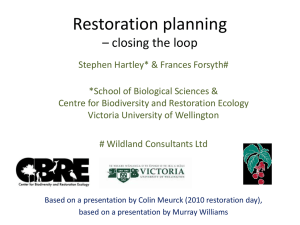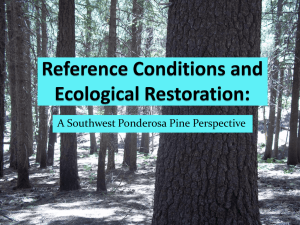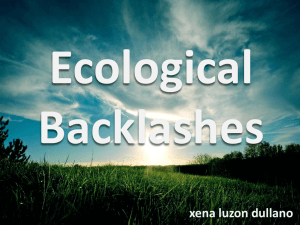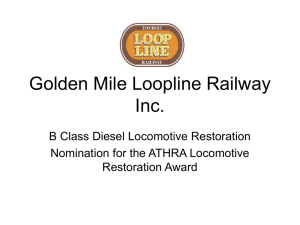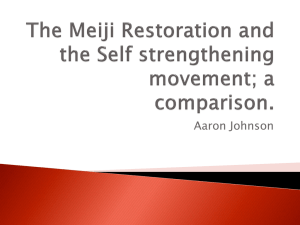Restoration Ecology
advertisement
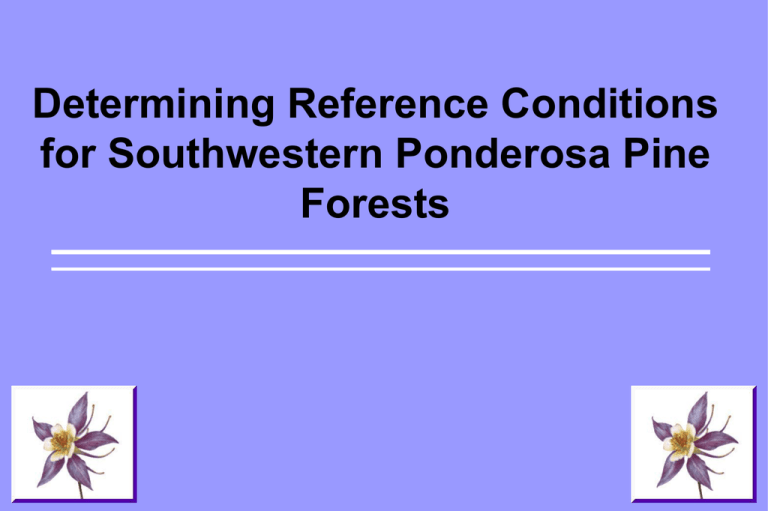
Determining Reference Conditions for Southwestern Ponderosa Pine Forests GOALS FOR LECTURE 1. You will be able to define ecological restoration. 2. You will be able to define reference conditions and how reference conditions are determined. 3. You will be able to discuss reference conditions in the context of southwestern ponderosa pine forests. WHAT IS ECOLOGICAL RESTORATION??? What is Ecological Restoration? The Society of Ecological Restoration (SER) defines ecological restoration in its mission statement as “the process of assisting the recovery and management of ecological integrity. Ecological integrity includes a critical range of variability in biodiversity, ecological processes and structures, regional and historical context, and sustainable cultural practices” (Society for Ecological Restoration 1996). Ecological Restoration Need to identify ecological restoration goal, identify the restoration potential of a site, how to conduct the restoration, and how to evaluate the success of restoration. * REFERENCE CONDITIONS Reference Conditions The range of historical or natural variability in ecological structures and processes that reflect evolutionary history, disturbance regimes, and abiotic and biotic conditions (Covington et al. 1997). HOW DO YOU DETERMINE REFERENCE CONDITIONS??? PONDEROSA PINE •Ponderosa pine (Pinus ponderosa) trees grow in every state found west of the Great Plains •In Colorado, ponderosa pine trees are commonly found on mesas to the montane from 5,000-9000 ft •In the San Juan Mountains, pure stands of ponderosa pine can be found on sandstone substrates from 6,500-8,000 ft Drawing by Robert Petty in “Graced by Pines” 1994 PONDEROSA PINE PONDEROSA PINE HISTORICAL DATA WRITTEN RECORDS Lt. Edward Beale, 1857 (northern Arizona) “A vast forest of gigantic pines, intersected frequently with open glades, sprinkled all over with mountains, meadows, and wide savannas, and covered with the richest grasses, was traversed by our party for many days.” C. DuBois, 1903 (San Juan Mountains) “Throughout the [“bull” or ponderosa pine] type there is good cattle range, consisting of blue-stem grass beneath the trees and bunch grass in the parks. The underbrush is very heavy, chiefly oak brush, choke-cherry, scarlett thorn, and wild rose. Reproduction of bull pine is poor.” PHOTOGRAPHS Courtesy of Cline Library Special Collections, Northern Arizona University 1911 1928 1985 RESEARCH Woolsey 1910 Forest Stand Inventory DBH CLASS DBH RANGE 1985/87 1962 1910 6 4.6-7.5 68.0 45.0 6.3 9 7.6-10.5 36.1 21.8 3.2 12 10.6-13.5 18.1 11.1 2.5 15 13.6-16.5 8.8 6.6 2.2 18 16.6-19.5 4.5 4.0 2.0 21 19.6-22.5 2.3 * 1.8 24 22.6-25.5 1.3 * 1.4 27 25.6-28.5 0.6 * 0.7 30 28.6+ 0.4 0.6 0.8 140.0 93.6 20.8 TOTAL CONTEMPORARY DATA FIRE SCARS EURO-AMERICAN SETTLEMENT GRAZING LOGGING FIRE SUPPRESSION LOS ALAMOS OTHER CONTEMPORARY DATA *SPECIES COMPOSITION AND STRUCTURE *SOIL SEED BANK *BIOTIC AND ABIOTIC SOIL CHARACTERISTICS *DEAD/DOWN WOODY MATERIALS *TRADITIONAL ECOLOGICAL KNOWLEDGE REFERENCE CONDITIONS SOUTHWESTERN PONDEROSA PINE Fire- Key disturbance that regulates ponderosa pine forests *Low intensity fires (2-20 year interval) *Large diameter trees interspersed with grassy meadows *Diverse, productive herbaceous understory WHO USES THIS INFORMATION? Governmental Agencies-National Park Service, Forest Service, BLM State and Local Government- e.g., Montezuma County (Ponderosa Pines Project), Boulder Mountain Parks Conservation Organizations-The Nature Conservancy, Grand Canyon Forest Trust General Public-e.g., where to build a house (fire-prone environment, floodplain, etc.), where to recreate, forming opinions on public land management actions GOALS FOR LECTURE 1. You will be able to define ecological restoration. 2. You will be able to define reference conditions and how reference conditions are determined. 3. You will be able to discuss reference conditions in the context of southwestern ponderosa pine forests. QUESTIONS?? Tree Canopy Data for the Gus Pearson Natural Area, Arizona for 1876 and 1990 Components of Ecological Restoration Four Main Components: 1) Cultural * Native Americans played an important role in the evolutionary history of many ecosystems through their interactions with the natural world. * Native Americans used fire as a tool for hunting, promoting/discouraging specific plant species which differs from lightning fires in seasonality, frequency, and intensity. Components of Ecological Restoration Four Main Components: 2) Economical * How much will the restoration project cost to plan, implement, and monitor? * What are the economical benefits from restoration (immediate and long-term)? Components of Ecological Restoration Four Main Components: 3) Social * Need to look at restoration as an outcome of complex interactions between nature and society and divergent social and political views within society. * Need to develop common ground among all participants when identifying and planning restoration projects. Components of Ecological Restoration Four Main Components: 4) Ecological * Need to identify ecological restoration goal, identify the restoration potential of a site, how to conduct the restoration, and how to evaluate the success of restoration. * Need to identify a spatial and temporal context for ecological restoration. * REFERENCE CONDITIONS
